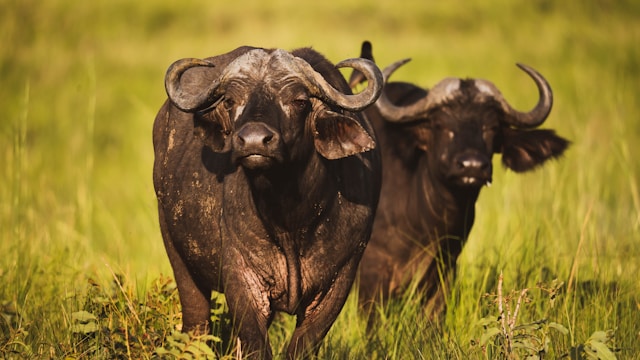Nestled in the western part of Uganda, Queen Elizabeth National Park stands as one of Africa’s most diverse and captivating wildlife reserves. Covering an area of 1,978 square kilometers, the park is renowned for its stunning landscapes, rich biodiversity, and remarkable conservation efforts. From vast savannah plains to lush forests and winding waterways, Queen Elizabeth National Park offers visitors a mesmerizing journey through Uganda’s natural wonders.
History and Origins
Established in 1952 as Kazinga National Park, the area was later renamed Queen Elizabeth National Park in 1954 to commemorate Queen Elizabeth II’s visit to Uganda. The park’s origins stem from the vision to preserve the region’s unique ecosystems and wildlife habitats. Today, it stands as a testament to Uganda’s commitment to conservation and ecotourism.
Geography and Landscape
Queen Elizabeth National Park boasts a diverse landscape characterized by rolling savannah plains, dense forests, volcanic features, and the tranquil waters of the Kazinga Channel and Lake Edward. The park’s topography is shaped by the majestic Rwenzori Mountains, also known as the “Mountains of the Moon,” which form a breathtaking backdrop to the park’s scenery.
The park’s diverse ecosystems support a remarkable variety of wildlife, including African elephants, lions, leopards, buffalo, and Uganda kob. It is also home to over 600 species of birds, making it a paradise for birdwatchers and ornithologists.
Wildlife and Biodiversity
One of the park’s main attractions is its thriving wildlife population. Visitors to Queen Elizabeth National Park have the opportunity to embark on game drives, boat safaris, and guided nature walks to witness the park’s diverse inhabitants up close. The famous tree-climbing lions of Ishasha are a highlight for many visitors, while the Mweya Peninsula offers panoramic views of the park’s vast plains and waterways.
The Kazinga Channel, a natural waterway that connects Lake George and Lake Edward, is a haven for hippos, crocodiles, and numerous bird species. Boat safaris along the channel provide a unique opportunity to observe these animals in their natural habitat while enjoying the stunning scenery of the surrounding landscape.
Activities and Attractions
Queen Elizabeth National Park offers a wide range of Uganda adventures activities and attractions to suit every traveler’s interests. Game drives are a popular way to explore the park and encounter its abundant wildlife. Experienced guides lead visitors through the park’s various ecosystems, sharing insights into the behavior and habitats of the animals that call Queen Elizabeth home.
For those seeking a more leisurely experience, boat safaris along the Kazinga Channel offer a tranquil journey through one of Africa’s most biodiverse waterways. The channel is teeming with wildlife, providing endless opportunities for wildlife viewing and photography.
Nature walks and birdwatching tours allow visitors to explore the park’s diverse habitats on foot, accompanied by knowledgeable guides who provide valuable insights into the park’s flora and fauna. The Kyambura Gorge, home to a population of chimpanzees and other primates, is a popular destination for primate tracking and guided forest walks.
Conservation and Community Engagement
Queen Elizabeth National Park plays a vital role in conservation efforts in Uganda, serving as a sanctuary for endangered species and a model for sustainable tourism practices. The park works closely with local communities to promote environmental awareness and support community-based conservation initiatives.
Through revenue generated from tourism activities, the park contributes to the development of surrounding communities, funding projects related to education, healthcare, and infrastructure. By engaging local residents in conservation efforts and promoting responsible tourism practices, Queen Elizabeth National Park seeks to ensure the long-term preservation of Uganda’s natural heritage.
Visitor Information and Accommodation
For visitors planning a trip to Queen Elizabeth National Park, there are several accommodation options available within and around the park. From luxury lodges and tented camps to budget-friendly guesthouses and campsites, there is something to suit every traveler’s preferences and budget.
The park’s main visitor center, located at Mweya Peninsula, provides information on park activities, wildlife sightings, and conservation efforts. Knowledgeable park rangers and guides are on hand to assist visitors and ensure a memorable and safe experience in the park.
Conclusion
Queen Elizabeth National Park stands as a testament to Uganda’s commitment to conservation and ecotourism. With its stunning landscapes, diverse wildlife, and rich cultural heritage, the park offers visitors a truly unforgettable experience in the heart of Africa. Whether embarking on a thrilling game drive, exploring the tranquil waters of the Kazinga Channel, or immersing oneself in the park’s rich biodiversity, Queen Elizabeth National Park promises an adventure like no other. As Uganda’s premier wildlife destination, it continues to inspire and captivate travelers from around the world, inviting them to discover the wonders of Africa’s wild beauty.


